Ferret FAQs
What does my ferret need for veterinary
care?
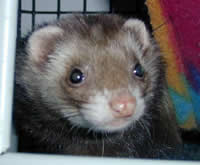 Ferrets are susceptible to colds, flu, canine distemper,
rabies and heartworm. Shots that need to be given annually are
for canine distemper and rabies.
Ferrets are susceptible to colds, flu, canine distemper,
rabies and heartworm. Shots that need to be given annually are
for canine distemper and rabies.
Canine Distemper: The reason
for vaccinating against canine distemper is very important –
You can expose your ferret to this disease without knowing it.
Distemper is an airborne disease – that means it could be on
your clothes, your shoes, your hands and all it takes is one
exposure for your ferret, if not protected. And distemper is
99% fatal. Vaccinating with the feline version gives your ferret
no protection at all – it must be the canine variety. Ferrets
can be treated using a dog version – called Galaxy-D or their
own version – Purevax-D .
Rabies: The reason for vaccinating
against rabies is that every animal which has hair or fur can
transmit the rabies virus. It can only be spread through direct
contact, but should your ferret bite or scratch someone, they
can demand that your ferret be tested. In order to test for rabies,
the vet has to kill the animal. Ferrets have better protection
under the law now, but it's better to have a current vaccination
history. Ferrets have their own Rabies vaccine – Imrab – 3 .
Heartworm: If you live in an area with mosquitoes,
your ferret should be protected against heartworm disease. The
product used is usually the feline version of heartworm preventative,
and is mostly in a palatable form. Heartworm also can be fatal
if untreated. Heartgard for cats is usual prescription.
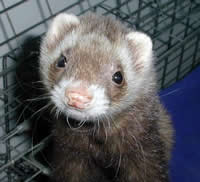 Colds/Flu:
There is no preventative currently for the common cold and flu.
If you are sick, then take the proper precautions to prevent
spreading to your ferret. They are very susceptible to these
viruses and can trade them back and forth with you.
Colds/Flu:
There is no preventative currently for the common cold and flu.
If you are sick, then take the proper precautions to prevent
spreading to your ferret. They are very susceptible to these
viruses and can trade them back and forth with you.
Regular Veterinary
visits: A ferret-friendly vet should be located before an emergency
occurs. Regular yearly visits for at least shots helps a vet
know your ferret and can help catch disease in the early stages.
Blood panels and tests for a ferret can also be early indicators
of problems and help in treatment and diagnosis of illness.
Changes
in weight, loss of hair, lack of energy, loss of appetite or
drinking, strange colored feces or diarrhea, bumps that appear
on the body, or just the feeling "he is just not acting
right" are warning signs
that should not be ignored and indications that a vet visit is
needed. A small fee to exam the ferret to tell you that everything
is okay is very small compared to the guilt you would feel if
something is really wrong and treatment was not sought.
Back to Top
What
should I feed my ferret? How available should food and water
be?
A good diet for a ferret is one that consists
of high protein, high fat, and low fiber diet. Just as important
as the percentages of protein and fat, are what is used to obtain
them. Ferrets are in the genus of Carnivora – carnivores. This
means that their diet should consist of primarily meat or meat-based
protein, not vegetable or fiber.
Ferrets have a very high metabolism
(this is how quickly your body processes food). Average time
for complete digestion is 3 – 4 hours, so food should be available
at all times, unless otherwise recommended by a vet.
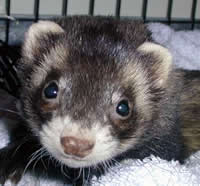 Most folks
tend to feed pre-packaged kibble. A good diet of kibble will
show at least 32% protein, 20% fat. The first 2 or 3 ingredients
on the bag or box should be meat. Acceptable meats are: poultry,
chicken, turkey, beef, lamb, fish. The first ingredients should
not be: corn, meal, rice, vegetable fiber. These are often cheap
substitutes for meat protein. A general rule of thumb is: cat/kitten
foods sold in a grocery store will not provide the proper nutrition
for a ferret. The more fiber and vegetable matter that is in
a diet means that the ferret will produce more waste – i.e. fecal
matter in the litter box. A quality diet will have less waste
and less volume.
Most folks
tend to feed pre-packaged kibble. A good diet of kibble will
show at least 32% protein, 20% fat. The first 2 or 3 ingredients
on the bag or box should be meat. Acceptable meats are: poultry,
chicken, turkey, beef, lamb, fish. The first ingredients should
not be: corn, meal, rice, vegetable fiber. These are often cheap
substitutes for meat protein. A general rule of thumb is: cat/kitten
foods sold in a grocery store will not provide the proper nutrition
for a ferret. The more fiber and vegetable matter that is in
a diet means that the ferret will produce more waste – i.e. fecal
matter in the litter box. A quality diet will have less waste
and less volume.
Why? Back to the carnivore. Humans are omnivorous
– we eat plant and animal matter. Our bodies are equipped with
something called a caecum. This is what the body uses to digest
fiber. Ferrets, as strict carnivores, lack the caecum and this
lack makes it very difficult to process vegetable matter – that's
why they produce more waste.
Some examples of ferret friendly
diet: Totally Ferret, Iams Kitten Food, Pro Plan Kitten Food,
8in1 Ultra blend diet, Shepard & Greene ferret food, Science
Diet Kitten, Innova cat food, Mazuri Ferret food.
Some not-so-ferret-friendly
diets: Kaytee Ferret Fiesta, Chef's blend, Meow Mix, Cozy Kat,
Purina Cat chow, Deli Cat, Friskies, Whiskas.
Food bowls: Food
bowls that attach to the sides of cages are preferred over heavy
ceramic bowls that bored ferrets will push around the cage. Stainless
steel bird bowls, Croc-lock bowls, and other small animal bowls
that can be securely fastened to the cage will result in less
wasted food.
Water: Water should be available for your ferret
at all times – again, based on metabolism. Bottles are preferred
over bowls, as ferrets tend to think of bowls in their cages
as play toys and revel in pushing them around with their noses.
Changing the water daily keeps the water fresh.
Back to Top
Will my ferret
use a litter box? What can I use? Litter box training:
Ferrets
will use a litter box, though they may not be as accurate as
a cat. Young ferrets (called kits) will often consider a clean
litter box a place to play. Ferrets are latrine animals, and
with a little work, will become trained to use a box while in
a cage.
If your ferret is using a corner other than where
the litter box is located, then its time to fool your ferret.
They will usually not go to the bathroom where they eat, sleep
or drink – so placing a food bowl, water bottle or bedding in
the "bad" spot
will often stop that.
Rewarding a ferret by giving a treat when
you see them using the litter box helps. As does leaving the
ferret in its cage until they use the box before coming out to
play. That helps reduce the amount of "accidents" you
may have to clean up.
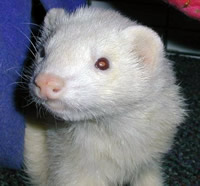 When training your ferret, never completely
clean the box – once the fresh litter is in place, put a little "used" wet
litter and one or two dried feces on the top to give them the
hint of where to go to the bathroom.
When training your ferret, never completely
clean the box – once the fresh litter is in place, put a little "used" wet
litter and one or two dried feces on the top to give them the
hint of where to go to the bathroom.
Fastening the litter box
to your cage will also help. Drilling holes and attaching the
litter box to the wire is one way of keeping the box in place.
Cage clips and other attaching devices are also available.
Appropriate
litter: There are many products on the market and its up to you
and your ferret – if the ferret does not like your choice of
litter, they may not use it! Types of litter to use are: Clay,
Clumping, Rabbit feed(alfalfa pellets), Woodstove pellets, recycled
newspaper, corncob and pine pellets. Each has its own drawbacks.
Clumping litter should never be used with a ferret that "snorkles" in
the box. (Snorkeling is what we refer to when the ferret buries
their head to the ears in box filler and runs their head through
the litter). Clay litter shouldn't be used if the ferret is allergic.
Woodstove pellets, pine pellets, newspaper and rabbit food should
not be used if the ferret starts to eat it. Corncob can be susceptible
to bacteria and fungal growth. Some are more costly than others
– and some may also be seasonal.
Inappropriate litter: Cedar,
pine or any kind of wood chips should not be used in a ferrets'
cage or litter box. Tests on wood chips have proven that they
cause respiratory problems and infections in ferrets with long-term
use.
Changing the box: In order to control odor, the
litter box should be scooped out daily and dumped weekly. Multiple
ferrets in a cage may result in more frequent dumping.
Back to Top
How can I
stop my ferret from nipping?
Ferrets are similar to puppies and
kittens – some behavior, like nipping, is just not appropriate.
It's your job to train them on what is acceptable and what is
not.
Teething: From age 5 weeks to 16 weeks, a ferret
is in the process of losing their baby teeth and gaining their
permanent teeth. While this is happening, they become very "mouthy" chewing
on everything and nibbling everyone. This is normal, but sometimes
they bite too hard.
 Part of normal ferrets' play involves biting
each other – so unlike when a dog or cat bites you, they don't
mean any harm – they want you to play with them!
Part of normal ferrets' play involves biting
each other – so unlike when a dog or cat bites you, they don't
mean any harm – they want you to play with them!
Training methods:
There are a number of methods for training a ferret not to bite.
Some may work on your ferret; others may not. The important thing
to remember is not lose your temper and to be consistent.
Time
out. This method involves putting the ferret back into the cage
when he/she has been bad. When the ferret nips, "NO, NO
BAD FERRET". If it happens again, put into their cage for
about 5 minutes. Let back out. Go through the same steps until
the ferret does not bite. Reward with praise or a treat.
Scruffing.
This can be incorporated into the time out method. To scruff
a ferret, grasp the fold of skin on the back of the neck between
the shoulder and head and pick the ferret up. This is where the
jill would pick up the kit when he/she was bad. When the ferret
bites, Scruff, "NO, NO BAD FERRET". Then put the ferret
down. Reward and praise when the ferret doesn't bite.
Training
aids. Bitter apple or lime, in both a paste and spray, can be
used as an effective training aid. Apply the spray to whichever
area of the body the ferret is nipping (usually hands or feet).
This is an alcohol-based spray, so never spray directly at the
ferret! The paste works well on objects that the ferret may be
chewing (electrical cords, cage bars etc) since it does not evaporate.
Bitter apple spray applied to a Q-tip can also help in biting.
When the ferret begins to nip, put the bitter apple or lime moistened
Q-tip in their mouth. The foul taste will usually deter them
from biting after a couple of attempts. Reward and praise when
the ferret doesn't bite.
Corporal punishment. This technique
is somewhat controversial and may or may not be effective. This
technique involves gently plucking or flicking on the nose. Extreme
care must be used, as a ferret's nose is very sensitive. This
is not recommended to be used by children.
 Direct approach. This
technique works best on finger nippers. When the ferret bites
your finger, gently push the finger back into the mouth. It's
uncomfortable for their mouth to be in that position, and they
can't bite down. Again, care must be used to not harm the ferret.
The goal is to change their behavior, not hurt them.
Direct approach. This
technique works best on finger nippers. When the ferret bites
your finger, gently push the finger back into the mouth. It's
uncomfortable for their mouth to be in that position, and they
can't bite down. Again, care must be used to not harm the ferret.
The goal is to change their behavior, not hurt them.
Bribery.
This technique works with some ferrets – especially toe/ankle
nippers. Instead of placing bitter apple or lime on your skin,
apply ferretone instead! When they come over to nibble, they
instead start to lick – Praise the ferret and pet them when they
do.
Water torture. This technique involves a spray water bottle.
Fill the bottle with cool water. When the ferret comes over to
bite, squirt them with water and tell them, "NO, NO BAD
FERRET".Reward and praise when the ferret doesn't bite.
Finally – consistency. This is the true key to
training. Once you have begun disciplining a ferret for biting,
you must be consistent in the rewarding of good behavior and
the "punishment" for
bad. Never make a game of it – if the ferret begins to dance
and chuckle (a ferret sound) then they did not understand that
you are applying disciplinary action – they think that you are
playing with them. Time out and scruffing usually works in this
situation to make them understand that this is not a new game
you are playing. They may hiss at you – normal behavior. Always
when disciplining use a calm but firm tone of voice.
Back to Top
What
kind of treats can I feed my ferret?
The important thing to remember
about treats is – they ARE treats. They should be limited in
the amount and the frequency of giving. Treats can be used to
reward good behavior or when they are being especially cute.
You can feed them some of the commercially packaged
treats, like Pounce , Ferret Bites, Ferretone , Ferretvite
, etc. Other well liked ferret treats can include banana, raisins,
cut grapes, shredded chicken, tuna, cheap cat food,
dehydrated chicken or beef dog treats, unsweetened cereal (Cheerios
) etc. All of these things should be given in moderation – for
example, no more than 4 or 5 raisins per week.
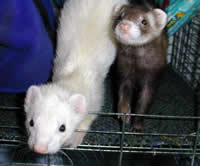 Ferretone
and Linatone are basically the same product. A good way to make
this oily treat more cost effective is to mix it with safflower
or extra virgin olive oil. This does not affect the taste and
dilutes down the product to make it last longer!
Ferretone
and Linatone are basically the same product. A good way to make
this oily treat more cost effective is to mix it with safflower
or extra virgin olive oil. This does not affect the taste and
dilutes down the product to make it last longer!
Things that
you shouldn't use as treats: Not all dog or cat treats are appropriate
for a ferret – any of the rawhide type treats can cause a blockage.
Cat treats with catnip are usually ignored by a ferret. Raw vegetables
should be given sparingly and carefully, as they can also cause
digestive problems. Candy, milk products and chocolate in general
should also be avoided.
Back to Top
What is a good cage to use?
A good
cage is one that has enough room for the ferret to move around,
contain a separate sleeping, eating/drinking, and latrine areas.
Aquariums are not recommended – It does not allow
for air circulation (ferrets can be prone to heat exhaustion
or stroke), the bottom will absorb urine and feces and be a haven
for bacterial/fungal growths which can harm your ferret, and
magnify sunlight, so they can get hot inside.
Wooden cages are
not the best – wood can also absorb oils, urine and feces and
will rot and smell. Treating the wood with polyurethane helps,
but must be reapplied regularly.
Wire cages are most often used
– they are airy, and come in all sizes and shapes. Minimum recommended
size for a single ferret is a two-story cage, measuring 30"h x 30"w
x 18"d. Setting up a cage:
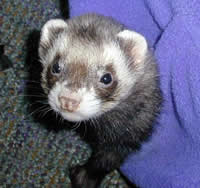 Setting up a cage is easy – litter
pan, food bowl, water bottle and bedding. Lining the wire bottom
of the cage and ramps with carpet, linoleum or vinyl flooring
will help protect the ferrets feet and pads while making cleanups
easy. Carpet samples or remnants can be purchased for a minimal
cost at any carpet/furniture store. Linoleum self-stick squares
and vinyl flooring pieces are also inexpensive, although I don't
recommend these on the ramp. Outdoor carpeting will also work.
Attaching the carpet (once cut to fit) is quick – puncture holes
in the carpet and run cable or twist ties through to attach to
the wire of the cage.
Setting up a cage is easy – litter
pan, food bowl, water bottle and bedding. Lining the wire bottom
of the cage and ramps with carpet, linoleum or vinyl flooring
will help protect the ferrets feet and pads while making cleanups
easy. Carpet samples or remnants can be purchased for a minimal
cost at any carpet/furniture store. Linoleum self-stick squares
and vinyl flooring pieces are also inexpensive, although I don't
recommend these on the ramp. Outdoor carpeting will also work.
Attaching the carpet (once cut to fit) is quick – puncture holes
in the carpet and run cable or twist ties through to attach to
the wire of the cage.
Food bowls that attach to the sides of
cages are preferred over heavy ceramic bowls that bored ferrets
will push around the cage. Stainless steel bird bowls, Crock-Lock
bowls, and other small animal bowls that can be securely fastened
to the cage will result in less wasted food.
Water bottles that
hang or attach to the side of the cage come in all shapes, sizes,
colors and designs. Easy to use, inexpensive to buy and easy
to clean.
Back to Top
What kind of bedding can I use?
Ferrets enjoy
being in a dark, enclosed place, so the more bedding in their
cage, the better.
Commercially available: You can buy at most
pets stores hammocks, Flying cubbies, Sleep sacks, or any other
type or design you can think of. Usually priced between $13.00
and $35.00. Some are fleece lined and some are not. Fleece can
be bad on the nails, as they may get caught if the nails are
not trimmed regularly.
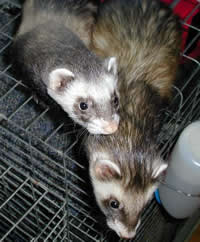 Homegrown: You can easily make or create
your own bedding. Old towels, sweat pants/shirts, T-shirts, baby
receiving blankets all make great bedding for a ferret at a reasonable
cost. Old pillowcases or old baby jumpers (watch the rubber backed
feet!) can become hanging hammocks with a crawl in area, so your
imagination is the only limit.
Homegrown: You can easily make or create
your own bedding. Old towels, sweat pants/shirts, T-shirts, baby
receiving blankets all make great bedding for a ferret at a reasonable
cost. Old pillowcases or old baby jumpers (watch the rubber backed
feet!) can become hanging hammocks with a crawl in area, so your
imagination is the only limit.
Design and create your own based
on one in the pet store – its not too hard to make them – all
it takes is a little material and some sewing skills.
Bedding
should be changed on a weekly basis to help control odor and
maintain a clean cage.
Back to Top
How can I stop my ferret from digging
and destroying my carpet or plants?
Ferrets have a natural instinct
for digging – this usually means that your carpet in front of
a door or your houseplants within their reach are often problems
for you and your ferret.
Digging in the plants: Easiest thing
to do is place them out of a ferrets' reach. This may not always
be the best solution, but it's the place to start. Always check
with your horticulturist about which plants are toxic to pets
before purchasing. Never use systemic poisons on plants that
may be reached by your ferret.
Diamond mesh, ¼" in diameter,
cut to fit the potted plant and trunk is usually enough to deter
even the most determined of ferrets. This mesh can be purchased
at most hardware stores.
Decorative rocks, placed in the pot
at least 2" in depth will help deter the ferret and make
the pot heavy enough to keep the ferret from moving them around.
Digging in the carpet: Ferrets will usually do
this in front of a doorway, determined to dig through the carpet
to get to the other side.
Cutting a carpet sample or remnant
to fit around the threshold of a door is usually the corrective
action taken. Clear plastic runners are also used when concerned
about appearance. Bitter apple sprayed on the carpet is usually
ineffective. A commercial product is available, called a Diplo-Mat
, can be purchased based on the width of the doorway. It's almost
impossible to break a ferret of digging at the carpet.
Back to Top
What is ferret
proofing? How do I make my house ferret-friendly?
Ferret proofing
is what you do to keep your ferret out of trouble and danger
in your home. It may be as simple as preventing access to a room
by always keeping the door closed. Installing child-safety locks
on your cabinets where poisons or harmful chemicals are kept.
Limiting access to such dangerous equipment as the stove, washer/dryer,
refrigerator and dishwasher. Removing harmful plants. Removing
or preventing access to recliners and sleeper sofas. Ensuring
that your ferrets can't escape through a window, door or any
access to the outdoors (like a dryer vent).
 To start ferret proofing
or making your home ferret friendly, take a couple minutes in
each room. Lay down on the floor and look around – are there
holes in the walls big enough? (ferrets can fit into openings
as small as 1" square) Are there any tempting wires or hiding
places? Is their access to the wall interiors? What about underneath
cabinets? Are their openings under the cabinet that a ferret
can squeeze into and be stuck or hidden? Is your box spring on
your bed protected? Furniture? Is there someplace that the ferret
can climb and possibly harm themselves? Anyplace the ferret may
get stuck and hurt themselves? Are your door stoppers rubber?
Are they out of the ferrets' reach?
To start ferret proofing
or making your home ferret friendly, take a couple minutes in
each room. Lay down on the floor and look around – are there
holes in the walls big enough? (ferrets can fit into openings
as small as 1" square) Are there any tempting wires or hiding
places? Is their access to the wall interiors? What about underneath
cabinets? Are their openings under the cabinet that a ferret
can squeeze into and be stuck or hidden? Is your box spring on
your bed protected? Furniture? Is there someplace that the ferret
can climb and possibly harm themselves? Anyplace the ferret may
get stuck and hurt themselves? Are your door stoppers rubber?
Are they out of the ferrets' reach?
Understand that ferret-proofing
your home is always a "work in progress" – just when
you think things are safe and they could never get into any trouble
– they prove you wrong. Start slowly, with one room and work
your way through the house.
Back to Top
What kind of maintenance care
does my ferret need?
Ears: Ears should be cleaned regularly,
about once a month. Some commercially available drops to clean
them are located at most pet stores. Care to not purchase over-the-counter
dog treatments or ear mite treatments should be used. Any notice
of dark, smelly wax in the ear of a ferret is usually a sign
of ear mites – and you should seek treatment by a vet to prevent
them. Nolvasan and Oti-Clens are among many ear wash solutions.
Apply the solution to a Q-tip and gently swab the ear – don't
go too far into the ear canal as you can damage the ear. Once
you are done, put a drop or two in each ear and let the ferret
shake their head – this will help remove debris deep in the canal.
Teeth: Teeth should be professionally cleaned by
a vet yearly or as needed. Tartar build up on the teeth can lead
to infections and tooth loss. A warning sign of disease is any
swelling or redness at the gum line; dark or discolored teeth;
loss of appetite or tenderness around the mouth. Home care is
possible for cleaning/scraping tartar and toothbrushes and paste
are available. Most often used are the finger brushes and malt
flavored toothpaste.
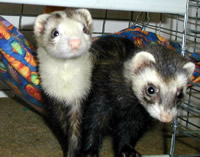 Nails: Nails should be trimmed about every
2-3 weeks. Locate the "quick" or
vein that runs through the nail and take care not to trim too
close – toenails can bleed profusely. A styptic pencil, cornstarch
or flour will help stop any bleeding. Cat nail clippers or small
animal trimmers are most commonly used.
Nails: Nails should be trimmed about every
2-3 weeks. Locate the "quick" or
vein that runs through the nail and take care not to trim too
close – toenails can bleed profusely. A styptic pencil, cornstarch
or flour will help stop any bleeding. Cat nail clippers or small
animal trimmers are most commonly used.
Two methods for trimming
– the 2-person and bribery technique.
2-person: One person scruffs
and holds the ferret, while the second quickly trims the nail.
Works great, but requires two people!
Bribery: Turn the ferret
on its back. Place some ferretone on the ferrets' belly and let
them find it. While they are licking the ferretone, clip the
nails. Only requires one person and is usually distracting enough
that the ferret never cares what you are doing!
Bathing: Bathing
a ferret is not truly necessary to control odor. Changing the
bedding and the litter box frequently do more than bathing. In
fact, the more often you bathe a ferret, the stinkier they will
become. Why? Because a ferret's fur contains oils, and bathing
strips the oils from the coat. So the ferret's body produces
more oils. More bathing, more oils.
You can spray your ferret
with a conditioning spray to make them smell "prettier" but
is really not necessary. Baths should be no more than once a
month, with a ferret shampoo. Usually, baths are only given when
a ferret has been bad and gotten into something! I bathe no more
than 3 times a year.
 Fleas: Ferrets can get fleas. Uncontrolled
infestations of fleas can be harmful to your ferret – a condition
known as "flea anemia", which could kill your ferret.
If you have a problem with fleas you need to treat the house,
the cage and the ferret at the same time. Do not use any kind
of flea dips on a ferret!
Fleas: Ferrets can get fleas. Uncontrolled
infestations of fleas can be harmful to your ferret – a condition
known as "flea anemia", which could kill your ferret.
If you have a problem with fleas you need to treat the house,
the cage and the ferret at the same time. Do not use any kind
of flea dips on a ferret!
Flea products that can be used are
anything that is appropriate for ferrets, kittens and cats. Not
dogs and puppies. Pyrethrins is the active ingredient usually
found in a good flea deterrent. Any lethargy, panting or frothing
at the mouth could mean an allergic reaction to that medication
and should be discontinued immediately. A vet visit may also
be appropriate.
Shampoo the ferret with either a ferret or kitten
flea shampoo and then follow up with the spray. Take care not
to get the shampoo or spray in the eyes.
Back to Top
What kind of toys
can I use to play with my ferret?
Toys – The joy of a ferret.
Many cat and dog toys are appropriate as well as some that you
can make yourself. Any hard rubber or vinyl toys, especially
those with fake sheepskin attached make wonderful toys for ferrets.
Round ball cat toys with bells or rattles inside keep ferrets
interested. Some ping pong balls will entertain as a ferret plays "nose
soccer". Soft furred toys with squeakers inside also are
favorites. Hemp or twine wrapped rattles or bell toys also keep
their interest. Some of the cat "fishing rod" toys.
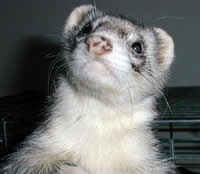 Homegrown toys include: boxes of any sort – soda,
paper, tissue. Empty gallon containers with holes cut in them.
Plastic or paper bags. Plastic drainage tubing (4" wide) that can be found
at most hardware stores. Remote controlled cars (watch the rubber
and small parts). Battery powered pig, dog, cow, etc. stuffed
toys that move and make sounds. Mazes and places to explore.
Your imagination (and the ferrets) are the only limits. A sand
box. A bathtub with a couple inches of water and a couple of
ping pong balls.
Homegrown toys include: boxes of any sort – soda,
paper, tissue. Empty gallon containers with holes cut in them.
Plastic or paper bags. Plastic drainage tubing (4" wide) that can be found
at most hardware stores. Remote controlled cars (watch the rubber
and small parts). Battery powered pig, dog, cow, etc. stuffed
toys that move and make sounds. Mazes and places to explore.
Your imagination (and the ferrets) are the only limits. A sand
box. A bathtub with a couple inches of water and a couple of
ping pong balls.
Toys that are not ferret friendly: Latex tops
the list – these are the soft, squeaking toys – pieces are easily
chewed off and swallowed – possibly causing a blockage. Avoid
these types and any other toys that seem to have small parts
that a ferret might chew on. Any tubing with an opening of less
than 4 inches.

